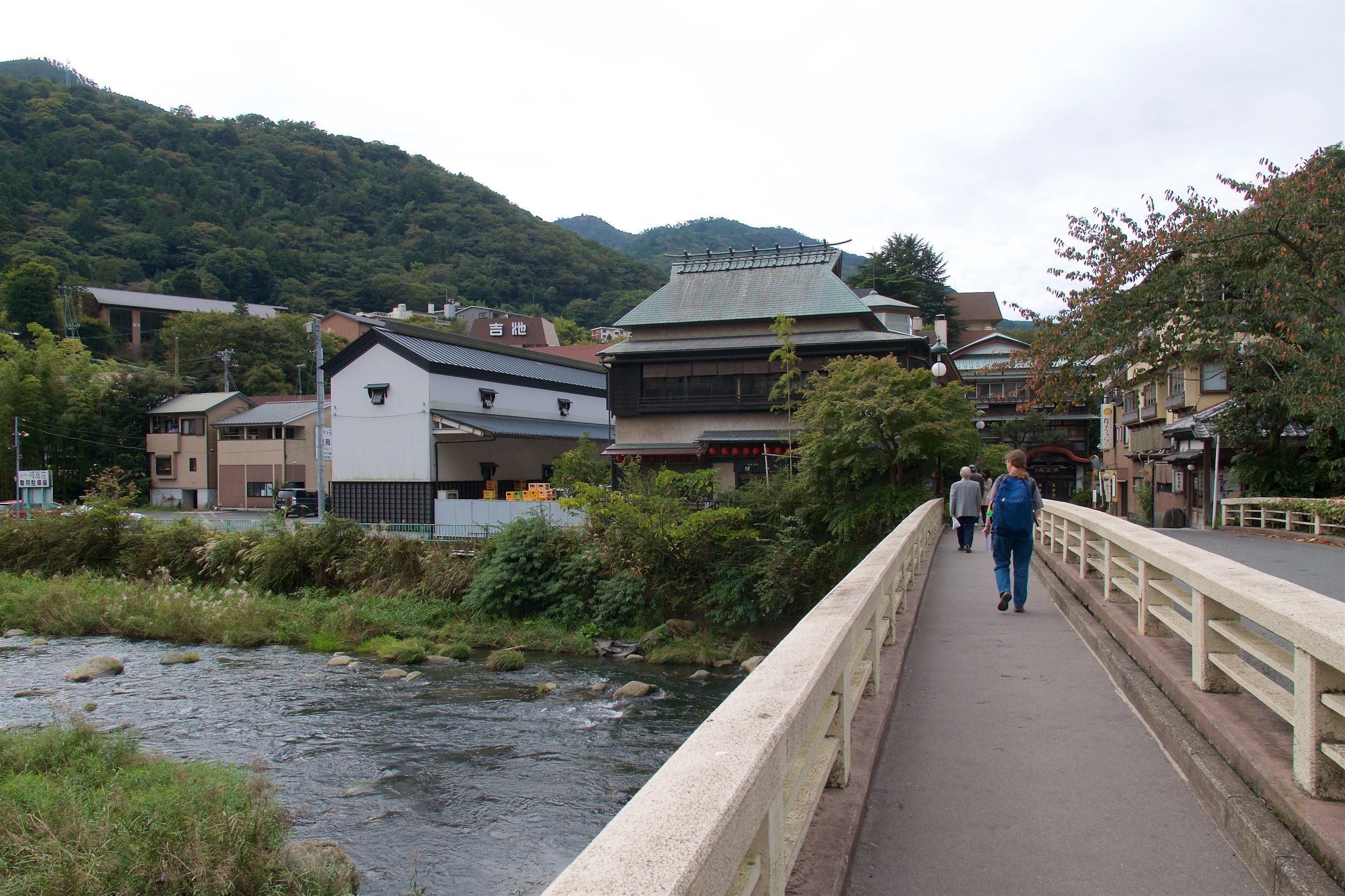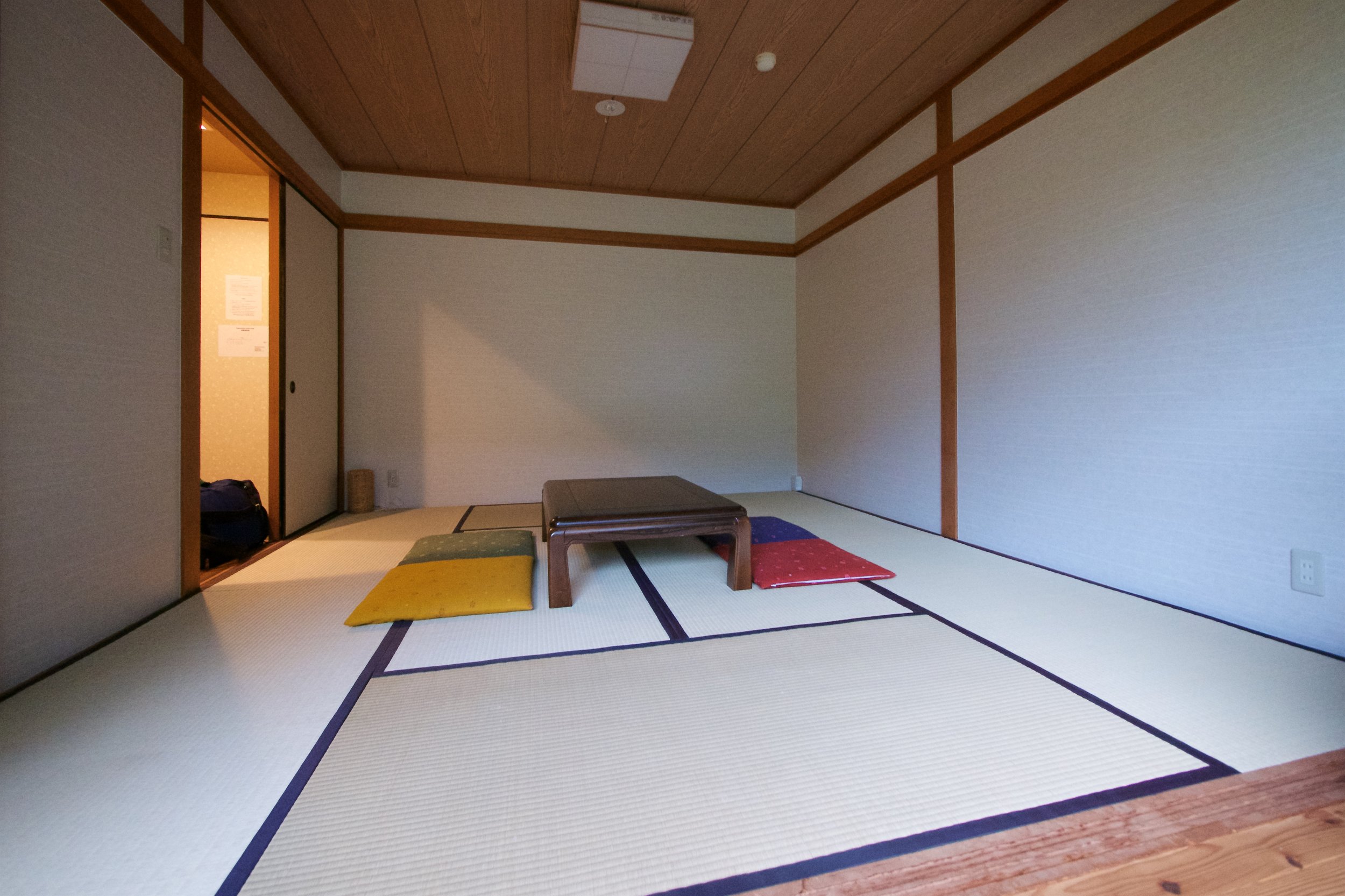Tokyo to Hakone, Monday 24-Oct
It was time to leave busy, urban Tokyo for quiet, rural Hakone. Sounds simple, but we took subways, a bullet train, local trains, a funicular, a gondola, a pirate ship, and a bus. We sometimes opt for as many different transit methods as we can get.
Shinkansen to Hakone
We wanted to make sure to allow plenty of time to figure out how to get to the train, so we got up early enough to pack and eat breakfast before the front desk opened. We timed it pretty well; waiting a minute after cleaning up our dishes, the window opened and we checked out.
Because of the time, we knew we were going to run into crowds on the subway. The first one was pretty tight, and we had to squeeze in with our bags, but not get too far from the door since we were only going a few stops. We transferred to the next train (different line, but this time we had to go outside to the other station), which was just as tight. However, at the next couple stops, fewer people got off than there were people waiting to get on. It seems commuters have a good sense of whether they can squeeze in. If they can, they turn around, back in, and keep pushing back until the doors can close. We saw one woman do it very gracefully.
We got off at Tokyo Station, and it was amazing how many people were walking to and fro. I would describe it as a stream of people, but it was more relentless than that; if you wanted to go somewhere different than the masses, you had a slow go ahead of you. We just went with the flow for a while until we got out of the subway part of the station, then found a dead spot without foot traffic to look around for where we wanted to go. We found our track and waited for our train.
Japan is known for its Shinkansen (bullet trains), and we were going to get a taste of one. We were at the beginning of the line, so the inbound train let its passengers off, then the cleaning crew began working. Workers swept through, removing the headrest covers, then they dropped new ones in place while reversing the seats to face the other direction. Next, they correctly positioned each new headrest cover and swept debris from the seats and floor. It's like what you'd see in the US for airplane turnover.
As we boarded, the similarities with an airline continued. The seats were very similar, but there's a lot more room, at least more than you get in coach. Before long, we were off. A few minutes later, another train went by us in the other direction, and I didn't feel it at all. I'm used to feeling the light rail sway when two trains pass each other, so no noticeable movement felt strange. I checked our speed, and it was about 70mph. Impressive. Later in our trip, I did notice a small amount of buffeting. This was at about 165mph.
There are trains that go much faster, but even at this “moderate” rate, we made good time. Including a few intermediate stops, it took us about 35 minutes to go the 51 miles between Tokyo Station and Odawara Station, our transfer point.
After exiting the Shinkansen section of Odawara Station, we looked for the counter where we could get the Hakone Free 3-Day Pass, which will allow us to ride the Hakone trains, busses, and transport in the Hakone Loop. It was easier to find and procure than we thought it would be, and that done, we found our way to the train. We didn't have to wait very long before it departed.
Upon arrival in Hakone, we set off to find where we were staying. We had a printed map as a backup, but the hot spot was working, so we could use live maps. The walk started off very rural and serene, even crossing rivers at a couple points. Then we started walking up a hill, and that kept going for quite a ways. And the road narrowed. Then it became a bit windier. And we were on a road with buses.
Having dodged traffic, we arrived at our destination, put our bags into storage, glanced around the common areas a bit. This place is very nice and has a great view out of the common room. We made a plan to get lunch in Gora, then take a look at the Hakone Loop, hoping the weather would be clear enough to see Mt. Fuji. The plan was to do part of it and see what the weather was like, turning around if we thought we couldn't see.
The Hakone Loop
We noticed the bus was only a minute or two away, so we waited for that to ride back to the train station, where we took a local train to Gora. What's fun with this particular line is it gains quite a bit of elevation, so to do that, they use switchbacks; the train keeps climbing until it hits a dead end, then a switch is thrown so the train goes on the other track to continue uphill from the previous tracks. We went through three switchbacks before getting off.
More than ready for lunch, we walked a bit towards a gyoza restaurant, where I got the regular gyoza, while Melody got Calamari gyoza. Of course, we shared so both of us could try each flavor, and split the rice, miso, and pickles that I got with mine.
While it looked a bit cloudy, we went to the cable car (more of a funicular) and rode it the several stops up to the top. In the middle, the track divided and we passed the downward car. There's a funicular in Los Angeles, Angels Flight, which is no longer running because they had troubles with the bypass in the middle being too close, causing damage.
After getting to the top of the cable car, we decided to just go ahead with the loop, since it was included with our pass anyway. Besides, riding a funicular then a gondola then a pirate ship? Can't go wrong with that.
We got onto the ropeway (gondola), which gave us a pretty good view of the valley, including a caldera where we saw lots of sulfur being vented out of the mountain. The endpoint of the funicular was Owakudani Station, which let us get closer to see, hear, and smell the sulfur vents. There are also hot springs in the valley, and you can buy chicken eggs boiled in the sulfur water which turns the shells black. We've seen them for sale in town, but have declined to buy them.
After looking around a bit, we went to the second, downward ropeway. This was the segment where, if Mt. Fuji were visible, we would see it. We didn't. What we did see was lots of green and our first glimpses of Lake Ashi.
Down at the bottom, we exited the gondola and went to board the pirate ship. Our timing was good since we only had to wait a couple minutes to get onto the ship, which ended up having lots of people on it. We started out on the outside deck, but since we were at elevation, it was somewhat chilly. After having taken in the lake view for a while, we went inside for the rest of the ride. After the ship docked, we got off, found the bus we wanted (the same one we took to the train station, but the other end of the line), and boarded as it was about ready to leave.
Then the fun began. But first, a note about what's considered a street. When we first arrived in Tokyo and we were trying to follow a map, we assumed a street is what we would think of a street, at least two lanes, possibly one if cars are parked on both sides of the street. We kept passing streets until we realized that we had to drastically scale down our concept of a “street”; what we would think of as alleys were actually streets. In maps of markets, it was all too easy to bypass aisles, since they were barely wide enough for two people to squeeze past each other.
In Hakone, the main drag is just wide enough for two busses to pass each other. The street our hostel was on? Two busses have to slow way down, swing partly off the street, then inch past each other. To up the difficulty level, the road from the boat to our hostel was extremely windy, with hairpin turns (the bus announcement said it was a meandering road). Our driver barely slowed to take these turns; the first time he did that, several passengers gasped and were wondering how safe it was. I have to say, the bus swayed very little, even though one's inner sense is saying that the bus is going to tip over. After a few of these turns, the other passengers got used to it and made sure to hang on.
Having made it to our stop accident-free, we got off, then immediately went way off the side of the road; there were several cars in the area and a bus trying to go the other direction. The photo below is taken after that other bus has left, but our bus was still trying to get around cars going the other direction.
In our room
We checked in, paid for our room, and were given the quick tour of the main floor. We then went up a floor and went into our room. We opted for a Japanese-style room, so the main area is covered with tatami mats. A table and cushions sit in the middle, which get moved to the side at night so futons can be set up. We have a nice, woodsy view out the window.
After settling in, we went across the street to the small store to get some take-out bento boxes for dinner, as well as some things for breakfast. After eating, we took turns going down to the onsen.
One of the features of this hostel is they have a pair of onsen, or hot baths, available to guests. One is inside, the other outside, and they switch on a schedule so you have the opportunity to try each. When Melody went down, the women were in the inside bath. By the time she came back, it was pretty close to when the change was happening, so I went down to the inside bath, too.
The water is about 40°C (104°F), so it's warm when you go in, but you adjust pretty quickly. When Melody was in the bath, there were a couple other women there. I had the whole bath to myself, and it was pretty relaxing, especially with the dripping sound of the water coming into the bath. There are a lot of hot springs in this area (thus the possibly active volcano with sulfur gasses being pumped out of it), but I'm not sure if the hostel has access to a hot spring source (although I'm guessing they do). The water definitely has some minerals in it, since my arms felt pretty buoyant.
Baths complete, futons put out, we were ready to catch some sleep.












